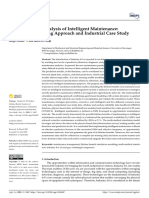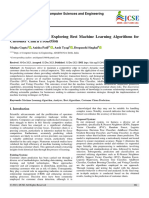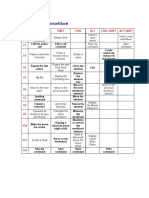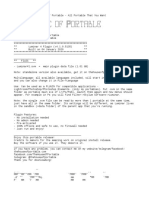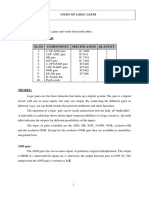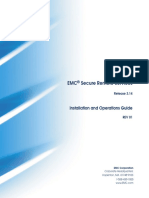TJ 15 2021 1 156 161
TJ 15 2021 1 156 161
Uploaded by
xjoaonetoCopyright:
Available Formats
TJ 15 2021 1 156 161
TJ 15 2021 1 156 161
Uploaded by
xjoaonetoOriginal Description:
Original Title
Copyright
Available Formats
Share this document
Did you find this document useful?
Is this content inappropriate?
Copyright:
Available Formats
TJ 15 2021 1 156 161
TJ 15 2021 1 156 161
Uploaded by
xjoaonetoCopyright:
Available Formats
ISSN 1846-6168 (Print), ISSN 1848-5588 (Online) Professional paper
https://doi.org/10.31803/tg-20210205105921
Predictive Maintenance of Cash Dispenser Using a Cognitive Prioritization Model
Archana Dixit*, Amol B. Mahamuni
Abstract: In this technical paper, we address the issue of predicting cash dispenser (addressed as ‘Device’ henceforth) failure by harnessing the power of humungous data from
service history, logs, metrics, transactions, and plausible environmental factors. This study helps increase device availability, enhanced customer experience, manage risk &
compliance and revenue growth. It also helps reduce maintenance cost, travel cost, labour cost, downtime, repair duration and increase meantime between failures (MTBF) of
individual components. This study uses a cognitive prioritization model which entails the following at its core; a) Machine Learning engineered features with highest influence on
machine failure, b) Observation Windows, Transition Windows and Prediction Windows to accommodate various business processes and service planning delivery windows, and
c) A forward-looking evaluation of emerging patterns to determine failure prediction score that is prioritized by business impact, for a predefined time window in the future. The
model not only predicts failure score for the devices to be serviced, but it also reduces the service miss impact for the prediction windows.
Keywords: Cash Dispenser Failure Prediction; Cognitive Prioritization Model; Feature Engineering; Machine Learning; Predictive Maintenance (PdM)
1 INTRODUCTION as static while features pertaining to maintenance/service
history, errors generated by the machines, environmental
Maintenance is a vital area that controls major cost changes, and transactions are treated as dynamic. Dynamic
savings and revenue. According to the International Society features are designed in view of aforementioned time
of Automation (ISA), more than $647 billion is lost each year windows. Observation window depicts the slice of data
due to downtime. All businesses have strived to achieve cost consumed by the model during model training and prediction
effective maintenance, high availability and customer generation. Transition window signifies the time required to
satisfaction. Retail Banks are no different. They too have process, prepare and make the data compatible to generate
grappled with maintenance processes to alleviate downtime predictions. Predictions are generated for four weeks into the
for a long time. Lack of a formal commitment and the future to allow adequate time for engineering team to act
easiness with which consumers can switch to competitors upon the predictions and perform maintenance activities on
make the process of building trust among consumers even the identified devices or their components.
tougher for retail bankers. The consumers need to be able to
get the service they want on a desired time. Otherwise, 66%
of them will simply switch banks on account of an
unfulfilling service needs.
Cash dispenser devices are getting more and more
powerful everyday by supporting capabilities such as
Passbook updating, Cash-Cheque Deposits, Money Transfer,
Statement printing, Voucher Printing, Electronic Purse Figure 1 Time Windows for Predictive Maintenance Model
Upload, Wire Transfer, Update Personal Information, Cross-
Selling, Advertising, Special Interest and so on. Sudden The remaining structure of this paper is organized as
failure and unplanned maintenance of these devices can have follows. Section 2 represents existing and related work on
substantial impact on not only banking specific services but predictive maintenance. Section 3 focuses on the proposed
also revenue generating streams. It also directly impacts method employed and describes the following; data used,
customer relationships. Therefore, there is an urgent need to exploratory data analysis, feature engineering, architecture of
rise from preventative or reactive maintenance to predictive the proposed solution followed by model training and its
maintenance. evaluation. Section 4 discusses the results obtained in detail.
This study introduces predictive maintenance Section 5 reviews the impact, stance and contribution of this
capabilities that can immensely help solution. Section 6 highlights the most relevant aspects of this
• Identify failures in advance leading to the optimization study and how it could easily be extended to other sectors.
of logistics and associated functions Finally, Section 7 concludes this paper by throwing light on
• Lower downtime by a significant factor the plausible approaches that could be leveraged in the future
• Spill over benefits from optimized cash in transit to make this Predictive maintenance solution more robust.
activities
• Increase reliability and operational efficiency. 2 RELATED WORK
This study uses three rolling time windows
‘Observation’, ‘Transition’ and ‘Prediction’ to determine An extensive study of literature, purposes and available
explanatory features and window of prediction. Features approaches is explained by the authors in [1]. Work carried
pertaining to inventory and machine components are treated out by other authors [4, 5] in this area also focuses primarily
156 TECHNICAL JOURNAL 15, 1(2021), 156-161
Archana Dixit, Amol B. Mahamuni: Predictive Maintenance of Cash Dispenser Using a Cognitive Prioritization Model
on generic approaches around predictive maintenance. Some 3.1 Exploratory Data Analysis (EDA)
of them focus on challenges and reliability aspect of PdM in
their study [6], while others focus only on the cost and An extensive EDA is performed during this study to
economic aspect [2, 15, 19]. While there are studies done for understand data distribution before applying any model.
Industrial and IoT devices [10, 11, 12, 14, 16], there are only Univariate, Bivariate & multivariate analysis is performed to
a handful studies available for cash dispenser devices [21] understand distribution, association & correlation of these
wherein only event/error logs are considered as variables to variables better. The following Figs. 4, 5, 6 & 7 are some of
perform Time Series Classification. Strong indicators of the visuals (illustrative not exhaustive) depicting the same.
failures could be gleaned out from service history, metrics,
transactions, etc. which is missing from the existing work in
this field. The focus of this study is to harness the power of
data points from service history, logs, metrics, transactions,
and plausible environmental factors to get a holistic view
around the device and component failure.
3 PROPOSED METHOD
This study uses a well-defined leading methodology
used by industry data miners all over the world called Cross
Industry Standard Process for Data Mining (CRISP-DM)
(depicted in Fig. 2). It entails framing business questions,
understanding data, preparing it for model training,
modelling, evaluation and deployment.
Figure 4 Inventory by Original Equipment Manufacturer (OEM)
Most of the inventory used in this study belongs to one
specific OEM model. In addition, CCDM module accounts
for most of the service tickets confirming that it is indeed the
most often used component during transactions.
Figure 2 Processes performed in CRISP-DM Methodology
This study leverages two years’ worth of data with
approx. 10K inventory. Multidimensional data encompasses
crucial information from inventory, service history, error
logs, transactions, and environment. The grain is at the device
component level. Translation Activity Report (TAR Code)
from inventory is used to identify modules/components for
prediction (TAR Code structure is illustrated in Fig. 3).
Preliminary analysis of data reveals that Cheque and Cash
Deposit Module (CCDM) is the most profoundly used
component of the device. Therefore, it is chosen to illustrate
the approach used in this study.
Figure 5 Service tickets by module/component
Service tickets show a downward trend, aptly so as banks
strive hard to reduce these numbers (Fig. 6).
Fig. 7 depicts primary problem areas for the CCDM
module.
Figure 3 TAR code structure
TEHNIČKI GLASNIK 15, 1(2021), 156-161 157
Archana Dixit, Amol B. Mahamuni: Predictive Maintenance of Cash Dispenser Using a Cognitive Prioritization Model
features ‘Err Type 1 Count’, ‘Err Type 2 Count’ and so on
are computed for each error type. Error time elapsed features
are also computed for each error type. Mean Time Between
Failure (MTBF) features are computed too using error
information. Features Avg MTBF, Weighted MTBF, etc. are
computed using statistical measures. Ticket features ‘Last
Preventive’, ‘Preventive Ticket Count’, ‘Repair Count’, etc.
are computed using aggregation and business rules. These
dynamic features contribute to significant chunk of
explanatory variables used in this study. Target variable has
two classes; ‘Failure’ & ‘Operational’ making it a binary
classification supervised machine-learning problem. All
these features are generated for each module.
3.3 Predictive Maintenance Architecture
Figure 6 Service tickets Monthly Trend
The following flow represents the predictive
maintenance (PdM) architecture employed in this study (Fig.
8). Data from various sources is collected and integrated into
a single coherent source. Various data wrangling and
munging techniques are leveraged to make it tidy and
compatible for machine learning model training. Features are
generated with respect to both time windows and business
rules.
Figure 8 Predictive Maintenance Architecture
This study uses DB2 database to extract and store
predicted results for subsequent actions. It leverages open
Figure 7 Problem areas for CCDM module
source programming language R to perform data extraction,
data preparation, data transformation, statistical modelling,
Our EDA does not exhibit any prominent issues with the machine learning model building, training & evaluation.
data with respect to missing values or outliers. Data is mostly Meaningful actionable insights are also extracted using R’s
clean and tidy. visualization libraries. Generated predictive insights are used
for optimized resource allocation, effective maintenance and
3.2 Feature Engineering inventory optimization.
Predictions are generated at module or component level 3.4 MODEL TRAINING & EVALUATION
and therefore, features are also engineered for each module.
As described earlier, there are two types of features used in Data for CCDM module suffers from imbalance of
this study; static & dynamic. Static features are time windows classes; ‘failure’ & ‘Operational’. Therefore, sampling
independent and dynamic features respect time windows techniques; upsampling, downsampling, SMOTE are
mentioned beforehand. employed to create a dataset with balanced classes. Inbuilt
Inventory details like ‘OEM’, ‘Age’, ‘TAR Action’, weightage techniques provided in R libraries are also
‘TAR problem’ etc. are static. Only active inventory leveraged to overcome class imbalance issue. Cross
(Devices that are not yet deinstalled) is considered for this validation and bootstrapping strategies are used in splitting
study. ‘Last Failure’, ‘Uptime’, ‘Last Visit’ etc. are computed train and test datasets to tackle overfitting issues. Numerous
using Observation Window and most recently closed ticket. experiments are carried out for each module and algorithm
Transaction features ‘Operation Count’, ‘Served Count’, combination by tuning various hyperparameter nobs to arrive
‘Reversed’ etc. are created by performing aggregation. Error at the optimal parameter values resulting in best performance
158 TECHNICAL JOURNAL 15, 1(2021), 156-161
Archana Dixit, Amol B. Mahamuni: Predictive Maintenance of Cash Dispenser Using a Cognitive Prioritization Model
of the model. Figs. 9 - 11 depict results for few of such
experiments.
The following algorithms are used to perform model
training and prediction of failure for each module;
RandomForest, XGBoost, Support Vector Machines,
Adaboost, and Generalized Linear Model. Multiple models
are trained and validated before selecting a best one for
scoring and prediction on new unseen data.
Figure 11 Recall and Precision for AQ (CCDM) module for experiment 3
In this study we are more concerned about how many of
the actual failures are predicted as failures by the model, i.e.
recall rather than vanilla accuracy or the model. Recall is
mathematically defined as the ratio of accurately classified
positive classes by model and actual positive classes.
Therefore, in our study we focused on reducing Type II error
or false negatives to achieve the best possible recall.
Figure 9 Recall and Precision for AQ (CCDM) module for experiment 1
4 RESULTS
Subsequently, it is observed that the ensemble algorithm
Random Forest performs best for the data at hand. It gives us
the highest recall and outperforms other algorithms.
Generated insights could also be categorized as high,
medium or low based on the prediction probability of each
module/component to specify severity of the failure. High
severity failures may then be attended to on a priority basis.
This novel framework preserves time-driven business
process in perspective while generating predictions to
facilitate adaption based on relatedness, reliability and
efficiency factors.
Figure 10 Recall and Precision for AQ (CCDM) module for experiment 2
Figure 12 Recall and Precision for AQ (CCDM) module using Random Forest
TEHNIČKI GLASNIK 15, 1(2021), 156-161 159
Archana Dixit, Amol B. Mahamuni: Predictive Maintenance of Cash Dispenser Using a Cognitive Prioritization Model
5 OUTLOOK & IMPACT • Sensor Data could be married with existing
multidimensional data to enrich and form 360-degree
There may be a reduction of approx. 40 - 50% in reactive view of devices and respective components
tickets if generated predictive insights are taken into account • Inclusion of data indicating any kind of social unrest
and acted upon well within the predictive window. leading to vandalism may help boost model’s prediction
Fig. 13 describes predictions generated for two rounds power.
for illustrative purposes. Prediction impact analysis is • This could easily be extended to predict failures in Data
performed by visualizing device count with prediction centers, servers, and other IT infrastructure devices
failures vs device count with reactive tickets for failure in • The state-of-the-art techniques Deep Learning, LSTM,
future prediction window. There were sixteen out of total HTM may also be leveraged to improve model
thirty devices that were predicted in round 1 would have performance and thereby prediction capabilities
reactive tickets in future. Similarly, there were ten out of total • Prescriptive capabilities could further enhance the
twenty-five devices that were predicted in round 2 would
solution and assist engineers in resolving issues with
have reactive tickets in future.
quick turnaround.
• This approach may be experimented with Python
programming language to design an overall offering.
Notice
This paper was presented at IC2ST-2021 – International
Conference on Convergence of Smart Technologies. This
conference was organized in Pune, India by Aspire Research
Foundation, January 9-10, 2021. The paper will not be
published anywhere else.
8 REFERENCES
Figure 13 Predictions vs Reactive Tickets for Prediction Rounds [1] Ran, Y., Zhou, X., Lin, P., Wen, Y., & Deng, R. (2019). A
Survey of Predictive Maintenance: Systems, Purposes and
Further, such analysis shows that there is an increase in Approaches. Retrieved from: https://arxiv.org/abs/1912.07383
device availability by 2% if this solution is implemented for [2] S. Spiegel, F. Mueller, D. Weismann, J. Bird (2018). Cost-
predictive maintenance. Meantime between failures of Sensitive Learning for Predictive Maintenance. Retrieved
individual components is almost doubled. The solution from: https://arxiv.org/abs/1809.10979
[3] Tuggener, L., Amirian, M., Rombach, K., Lörwald, S., Varlet,
identifies failures in advance leading to the optimization of
A., Westermann, C., & Stadelmann, T. (2019). Automated
logistics and associated functions. Downtime is also lowered Machine Learning in Practice: State of the Art and Recent
by a significant factor. First touch resolution is increased Results. https://doi.org/10.1109/SDS.2019.00-11
within a week of ticket logging. Repair duration, labor cost [4] Miller, K. & Dubrawski, A. (2020). System-Level Predictive
and travel costs are lowered noticeably too. Retail banks are Maintenance: Review of Research Literature and Gap
able to attain spillover benefits from optimized cash in transit Analysis. Retrieved from:
activities, as they relate to second line maintenance. https://arxiv.org/pdf/2005.05239.pdf
[5] Bousdekis, A., Lepenioti, K., Apostolou, D., & Mentzas, G.
6 CONCLUSION (2019). Decision Making in Predictive Maintenance: Literature
Review and Research Agenda for Industry 4.0. IFAC-
In this work, we have studied how machine learning PapersOnLine, 52(13), 607-612.
heuristic models augmented with sophisticated feature https://doi.org/10.1016/j.ifacol.2019.11.226
engineering mechanism could be used to empower retail [6] Meyer Zu Wickern, V. - Challenges and Reliability of
bankers by predicting component that are mostly likely to fail Predictive Maintenance. (2019). Challenges and Reliability of
Predictive Maintenance.
in the next four weeks. Multidimensional data from disparate
https://doi.org/10.13140/RG.2.2.35379.89129
touch points of devices is employed to facilitate predictive [7] Poór, P. & Basl, J. (2019). Predictive maintenance as an
maintenance in real time. intelligent service in Industry 4.0. Journal of Systems
This study could easily be prolonged to predict failure in Integration, 10(1), 3-10. https://doi.org/10.20470/jsi.v10i1.364
other devices such as POS machines, Self-checkout kiosks, [8] Paolanti, M., Romeo, L., Felicetti, A., Mancini, A., Frontoni,
etc. E., & Loncarski, J. (2018). Machine Learning approach for
Predictive Maintenance in Industry 4.0. The 14th IEEE/ASME
7 WAY FORWARD International Conference on Mechatronic and Embedded
Systems and Applications (MESA), 1-6.
This study has several avenues of enhancement to add https://doi.org/10.1109/MESA.2018.8449150
more capabilities into the overall Predictive maintenance [9] Schmidt, B., Sandberg, U., & Wang, L. (2014). Next
Generation Condition Based Predictive Maintenance. The 6th
solution.
International Swedish Production Symposium,
160 TECHNICAL JOURNAL 15, 1(2021), 156-161
Archana Dixit, Amol B. Mahamuni: Predictive Maintenance of Cash Dispenser Using a Cognitive Prioritization Model
https://www.researchgate.net/publication/318775487_Next_G
eneration_Condition_Based_Predictive_Maintenance.
[10] Bonci, A., Longhi, S., & Nabissi, G. (2019). Predictive
Maintenance System using motor current signal analysis for
Industrial Robot. The 24th IEEE International Conference on
Emerging Technologies and Factory Automation (ETFA),
1453-1456. https://doi.org/10.1109/ETFA.2019.8869067
[11] Cakir, M., Ali Guvenc, M., & Mistikoglu, S. (2020). The
Experimental Application of Popular Machine Learning
Algorithms on Predictive Maintenance and the Design of IIoT
based Condition Monitoring System. Computers & Industrial
Engineering, 106948. Available online 30 October 2020.
https://doi.org/10.1016/j.cie.2020.106948
[12] Maashi, M., Alwhibi, N., Alamr, F., Alzahrani, R., Alhamid,
A., & Altawallah, N. (2020). Industrial Duct Fan Maintenance
Predictive Approach Based on Random Forest. The 9th
International Conference on Information Technology
Convergence and Services (ITCSE 2020), 177-184.
https://doi.org/10.5121/csit.2020.100516
[13] Raza, A. & Ulansky, V. (2016). Modelling of predictive
maintenance for a periodically inspected system. Procedia
CIRP 59, 95-101. https://doi.org/10.1016/j.procir.2016.09.032
[14] Vibha, K., Pal, H., Bendigeri, M. V., & Panna, N. (2020).
Development of Predictive Maintenance System of Motors.
International Journal of Advanced Science and Technology,
29(7), 2344-2351.
[15] Jing Yu, D. T. & Wing-Keung, A. L. (2020). An Economic
Perspective on Predictive Maintenance of Filtration Units.
Retrieved from: https://arxiv.org/abs/2008.11070
[16] Zheng, H., Paiva, A. R., & Gurciullo, C. S. (2020). Advancing
from Predictive Maintenance to Intelligent Maintenance with
AI and IIoT. Retrieved from: https://aiotworkshop.github.io/
published/AIoT_4_Zheng_TechnicalPaper_KDD2020.pdf
[17] Serradilla, O., Zugasti, E., & Zurutuza, U. (2020). Deep
learning models for predictive maintenance: a survey,
comparison, challenges and prospect. Retrieved form:
https://arxiv.org/pdf/2010.03207.pdf
[18] Satta, R., Cavallari, S., Pomponi, E., Grasselli, D., Picheo, D.,
& Annis, C. (2017). A dissimilarity-based approach to
predictive maintenance with application to HVAC systems.
Retrieved from:
https://arxiv.org/ftp/arxiv/papers/1701/1701.03633.pdf
[19] Alsyouf, I. (2007). The role of maintenance in improving
companies’ productivity and profitability. International
Journal of Production Economics, 105(1), 70-78.
https://doi.org/10.1016/j.ijpe.2004.06.057
[20] Guillaume, A., Vrain, C., & Wael, E. (2020). Time series
classification for predictive maintenance on event logs.
Retrieved from: https://arxiv.org/pdf/1911.10996.pdf
Authors’ contacts:
Archana Dixit, Data Scientist
(Corresponding author)
IBM India
archana.dixit@in.ibm.com
Amol B. Mahamuni, Program Director
IBM India
mamol@in.ibm.com
TEHNIČKI GLASNIK 15, 1(2021), 156-161 161
You might also like
- Abdulmalek, Rajgopal - 2007 - Analyzing The Benefits of Lean Manufacturing and Value Stream Mapping Via Simulation A Process Sector CaseDocument14 pagesAbdulmalek, Rajgopal - 2007 - Analyzing The Benefits of Lean Manufacturing and Value Stream Mapping Via Simulation A Process Sector CaseDragan DragičevićNo ratings yet
- Why Predictive Maintenance Is Driving Industry 4.0: The Definitive GuideDocument13 pagesWhy Predictive Maintenance Is Driving Industry 4.0: The Definitive GuideAnonymous lIJl27QBXL100% (1)
- IPage Make Your Own Scalar Healing Device PDFDocument11 pagesIPage Make Your Own Scalar Healing Device PDFSadegh SimorghNo ratings yet
- Real-Time Data Analytics Case StudiesDocument37 pagesReal-Time Data Analytics Case StudiesHarrison HayesNo ratings yet
- 2020 - Machine Learning Approach To PredictiveDocument10 pages2020 - Machine Learning Approach To PredictiveRafaelRaiderLeoniNo ratings yet
- Base PaperDocument6 pagesBase PapertoomuchanshNo ratings yet
- Demand Forecasting in Retail Industry-DatasetDocument5 pagesDemand Forecasting in Retail Industry-DatasetAbir SarkarNo ratings yet
- Maximising Operational Uptime: A Strategic Approach To Mitigate Unplanned Machine Downtime and Boost Productivity Using Machine Learning TechniquesDocument13 pagesMaximising Operational Uptime: A Strategic Approach To Mitigate Unplanned Machine Downtime and Boost Productivity Using Machine Learning TechniquesInternational Journal of Innovative Science and Research TechnologyNo ratings yet
- (IJCST-V11I1P5) :jitendra Maan, Harsh MaanDocument6 pages(IJCST-V11I1P5) :jitendra Maan, Harsh MaanEighthSenseGroupNo ratings yet
- A Research Study On Unsupervised Machine Learning Algorithms For Early Fault Detection in Predictive MaintenanceDocument7 pagesA Research Study On Unsupervised Machine Learning Algorithms For Early Fault Detection in Predictive MaintenanceSayan BhattacharyaNo ratings yet
- Novity White Paper PRADocument6 pagesNovity White Paper PRAajayvgNo ratings yet
- Maintenance Strategies in The Era of IiotDocument9 pagesMaintenance Strategies in The Era of IiotElvis DiazNo ratings yet
- The Benefits of Predictive Maintenance in ManufactDocument9 pagesThe Benefits of Predictive Maintenance in Manufact1820222No ratings yet
- Applsci 12 10617 v3Document29 pagesApplsci 12 10617 v3Ariel CespedNo ratings yet
- sci8Document3 pagessci8Gangadhar GandudiNo ratings yet
- 1 s2.0 S2212827118312344 MainDocument6 pages1 s2.0 S2212827118312344 MainRajeevNo ratings yet
- Condition Monitoring EbookDocument13 pagesCondition Monitoring EbookFELIX VALERANo ratings yet
- Quantifying The Effects of Production Maintenance Decisions Using Discrete Event SimulationDocument9 pagesQuantifying The Effects of Production Maintenance Decisions Using Discrete Event SimulationDavid NyanguNo ratings yet
- predictive maintenanceDocument9 pagespredictive maintenancevaish2503100% (1)
- Sensores Basilea SuizaDocument17 pagesSensores Basilea SuizaXAILA ROB RONo ratings yet
- Predictive Maintenance in Industrial Systems Using Machine LearningDocument8 pagesPredictive Maintenance in Industrial Systems Using Machine LearningInternational Journal of Innovative Science and Research TechnologyNo ratings yet
- Lifetime Benefit Analysis of Intelligent Maintenance Simulation Modeling Approach and Industrial Case Studyapplied ScienDocument29 pagesLifetime Benefit Analysis of Intelligent Maintenance Simulation Modeling Approach and Industrial Case Studyapplied ScienFrank Joel Herrera ApaesteguiNo ratings yet
- Seminar Topic On Predictive Maintenance in Computer SystemsDocument13 pagesSeminar Topic On Predictive Maintenance in Computer Systemsgodwin collinsNo ratings yet
- Am Ruth Nath 2018Document8 pagesAm Ruth Nath 2018RafilloNo ratings yet
- final project reportDocument25 pagesfinal project reportthemistocles696969No ratings yet
- SSRN Id1914158Document9 pagesSSRN Id1914158Abdelghani BouchaalaNo ratings yet
- Auto-Spare Part Management ReportDocument43 pagesAuto-Spare Part Management ReportFaisal AslamNo ratings yet
- Advances in Engineering Software: Orlando DuránDocument9 pagesAdvances in Engineering Software: Orlando DuránorlandoduranNo ratings yet
- 12 - Application of Fuzzy TOPSIS and Harmonic Mitigation Measurement On Lean Six Sigma A Case Study in Smart FactoryDocument23 pages12 - Application of Fuzzy TOPSIS and Harmonic Mitigation Measurement On Lean Six Sigma A Case Study in Smart Factoryleylagale27No ratings yet
- A Data Analytics Model For Improving Process Control I 2022 Decision AnalytiDocument12 pagesA Data Analytics Model For Improving Process Control I 2022 Decision AnalytiVikash KumarNo ratings yet
- Cse Major Project Progress ReportDocument17 pagesCse Major Project Progress ReportAbhishek ChauhanNo ratings yet
- Research Paperr (Predictive Maintenance) - FinalDocument6 pagesResearch Paperr (Predictive Maintenance) - FinalAkansha sharmaNo ratings yet
- An Overview of The Application of MachinDocument15 pagesAn Overview of The Application of MachinCésar VásquezNo ratings yet
- A Survey on Customer Churn Prediction InDocument6 pagesA Survey on Customer Churn Prediction Inhuyendiu3124No ratings yet
- General Electric-Downtime With Predictive AnalyticsDocument14 pagesGeneral Electric-Downtime With Predictive AnalyticsFelipe MelgarejoNo ratings yet
- Retraction Retracted: Supply Chain Management System For Automobile Manufacturing Enterprises Based On SAPDocument11 pagesRetraction Retracted: Supply Chain Management System For Automobile Manufacturing Enterprises Based On SAPJeannica SalbillahNo ratings yet
- Artículo 4Document20 pagesArtículo 4Rosaly PerezNo ratings yet
- MaintenanceDocument47 pagesMaintenanceVincent Gabriel100% (2)
- AI-Powered+Predictive+Analytics+for+Vehicle+Maintenance+Scheduling (1)Document16 pagesAI-Powered+Predictive+Analytics+for+Vehicle+Maintenance+Scheduling (1)lt3871568No ratings yet
- Data Mining For Customer Service Support: S.C. Hui, G. JhaDocument13 pagesData Mining For Customer Service Support: S.C. Hui, G. JhaakmicahNo ratings yet
- 131-16-008 Adifa Akter Jusi (OM)Document42 pages131-16-008 Adifa Akter Jusi (OM)adifa mahmudNo ratings yet
- 1834-Article Text-7588-1-10-20200929Document5 pages1834-Article Text-7588-1-10-20200929محمد بورمضانNo ratings yet
- Sahasrabudhe2020 - Experimental Analysis of Machine LearningDocument7 pagesSahasrabudhe2020 - Experimental Analysis of Machine LearningbmdeonNo ratings yet
- Pharmaceutical Supply Chain Management and DTsDocument20 pagesPharmaceutical Supply Chain Management and DTsAurora menegattoNo ratings yet
- LibroDocument8 pagesLibrosebastianmelo82181No ratings yet
- 1-s2.0-S0278612522000796-mainDocument13 pages1-s2.0-S0278612522000796-mainBbd HjsNo ratings yet
- A Decision Support System For Demand Planning: A Case Study From Manufacturing IndustryDocument6 pagesA Decision Support System For Demand Planning: A Case Study From Manufacturing IndustryFelipe Tapia GómezNo ratings yet
- Modeling and Analysis of Customer ServicDocument4 pagesModeling and Analysis of Customer Servicfegegbelulegn741No ratings yet
- Artigo 1Document6 pagesArtigo 1Leonardo MasaoNo ratings yet
- Advances in Engineering Software: Orlando DuránDocument3 pagesAdvances in Engineering Software: Orlando DuránSreekumar RajendrababuNo ratings yet
- Fault AnalysisDocument10 pagesFault Analysissusheela bhatNo ratings yet
- Enabled Predictive MaintenanceDocument8 pagesEnabled Predictive MaintenancePooja YadavNo ratings yet
- Predictive Maintenance Based On Event-Log Analysis: A Case StudyDocument12 pagesPredictive Maintenance Based On Event-Log Analysis: A Case StudyNapoleón Hernandez Venegas100% (1)
- Aircraft MaintenanceDocument36 pagesAircraft MaintenanceDibya Dillip100% (2)
- Small Business Mobile App An Analytical Approach FDocument70 pagesSmall Business Mobile App An Analytical Approach Fkishorekirthik55No ratings yet
- Inbound 828402496349017739Document12 pagesInbound 828402496349017739rinettemarionetteNo ratings yet
- Development of Computer-Aided Maintenance Resources Planning (CAMRP) : A Case of Multiple CNC Machining CentersDocument10 pagesDevelopment of Computer-Aided Maintenance Resources Planning (CAMRP) : A Case of Multiple CNC Machining Centerssurekha dobaleNo ratings yet
- Atde 16 Atde210095Document10 pagesAtde 16 Atde210095Josip StjepandicNo ratings yet
- Vol 11 3Document5 pagesVol 11 3bhuvanesh.cse23No ratings yet
- IEEE-A Novel Predictive Maintenance Method Based On Deep Adversarial Learning in The Intelligent Manufacturing SystemDocument19 pagesIEEE-A Novel Predictive Maintenance Method Based On Deep Adversarial Learning in The Intelligent Manufacturing SystemWeiwei ChenNo ratings yet
- COA GTU Study Material Presentations Unit-5 11022020053257AMDocument64 pagesCOA GTU Study Material Presentations Unit-5 11022020053257AMJanvi PatelNo ratings yet
- PLC - BMS - Poc - Test - NTT DCDocument6 pagesPLC - BMS - Poc - Test - NTT DCUpasana Ashok PatilNo ratings yet
- (New) Best Way To Hack Whatsapp Group and Become Admin PDFDocument8 pages(New) Best Way To Hack Whatsapp Group and Become Admin PDFChetan KumarNo ratings yet
- E-Challan Payment Gateway: Government Receipts With A DifferenceDocument3 pagesE-Challan Payment Gateway: Government Receipts With A DifferenceBhanu GudluruNo ratings yet
- Java Lab RecordDocument29 pagesJava Lab RecordCyberDootNo ratings yet
- CSE3155 DCCN QBDocument3 pagesCSE3155 DCCN QBdeekshithkr12345No ratings yet
- FS-114 Manual v3Document38 pagesFS-114 Manual v3ARNo ratings yet
- Amcat Attempt 1Document18 pagesAmcat Attempt 1Pratik SabaleNo ratings yet
- "From DFD To Structure Chart": TCS2411 Software Engineering 1Document19 pages"From DFD To Structure Chart": TCS2411 Software Engineering 1Velmurugan RajarathinamNo ratings yet
- Function Keys in Microsoft ExcelDocument12 pagesFunction Keys in Microsoft ExcelPradeepTiwariNo ratings yet
- pkdp-203 0Document23 pagespkdp-203 0prasanna kumarNo ratings yet
- Advertising Agency Management System Project ReportDocument113 pagesAdvertising Agency Management System Project ReportChetan BokeNo ratings yet
- ECB9300 UsersManual V1 0Document62 pagesECB9300 UsersManual V1 0Lajos BányaiNo ratings yet
- Enhanced Mobile Broadband Simulation Through Matlab: Block DiagramDocument1 pageEnhanced Mobile Broadband Simulation Through Matlab: Block DiagramShashank SinghNo ratings yet
- 5G Technology: A Seminar Report Submitted in Partial Fulfillment of The Requirements For The Award of The Degree ofDocument16 pages5G Technology: A Seminar Report Submitted in Partial Fulfillment of The Requirements For The Award of The Degree ofhcNo ratings yet
- Architectural Patterns For Microservices - A Systematic Mapping StudyDocument13 pagesArchitectural Patterns For Microservices - A Systematic Mapping StudyDiego VintimillaNo ratings yet
- State Machine Replication - WikipediaDocument8 pagesState Machine Replication - Wikipediaaparna2405pandaNo ratings yet
- Intel Desktop Board D850MD/D850MV: Technical Product SpecificationDocument126 pagesIntel Desktop Board D850MD/D850MV: Technical Product SpecificationCube7 GeronimoNo ratings yet
- NO Nama Pengguna Type Komputer Prosesor Memory Hardisk OS NotebookDocument9 pagesNO Nama Pengguna Type Komputer Prosesor Memory Hardisk OS NotebookSyifa FauziyahNo ratings yet
- TT Study Guide Organized-2Document14 pagesTT Study Guide Organized-2thehiddenbalconyNo ratings yet
- Mobile Communications Chapter 1: IntroductionDocument18 pagesMobile Communications Chapter 1: IntroductionSourav ChowdhuryNo ratings yet
- Visual Programing (CS411) Assignment#03: Please Read All The Instructions Carefully Before Attempting The AssignmentDocument2 pagesVisual Programing (CS411) Assignment#03: Please Read All The Instructions Carefully Before Attempting The AssignmentHunaizah SaleemNo ratings yet
- Dynamics365for Financials PDFDocument813 pagesDynamics365for Financials PDFKakumanu Siva100% (1)
- Plugin NoteDocument2 pagesPlugin NoterachmadmahendraNo ratings yet
- LogcatDocument431 pagesLogcatAhmad MurtazaNo ratings yet
- Artificial IntelligenceDocument9 pagesArtificial IntelligenceTEHNo ratings yet
- 0004000000197100Document4 pages0004000000197100AldyNo ratings yet
- Dpco Lab ManualDocument53 pagesDpco Lab ManualBELMER GLADSON Asst. Prof. (CSE)No ratings yet
- Docu55297 EMC Secure Remote Services Release 3.14 Installation and Operations GuideDocument324 pagesDocu55297 EMC Secure Remote Services Release 3.14 Installation and Operations GuideRizwan KhanNo ratings yet





















